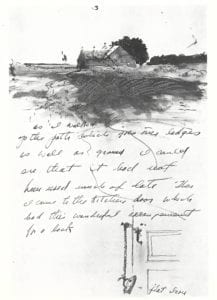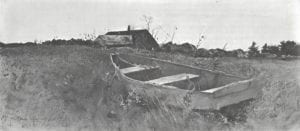Kierstin Utter
Detroit, Michigan, United States
Kyle Utter
New York, New York, United States

10 3/8 x 7 3/16”. June 19, 1954. Collection of Mr. and Mrs.
W.E. Phelps. Hofer, Philip, and Andrew Wyeth. Andrew Wyeth:
Dry Brush and Pencil Drawings, a Loan Exhibition Organized
by the Fogg Art Museum, 1963. New York: Distributed by
New York Graphic Society, 1963.
Andrew Wyeth completed his most iconic work, Christina’s World, in 1948. The painting came at a critical time, when post-World War II everyday Americans were beginning to purchase mass-produced automobiles. The ability to quickly move from city to suburbs was gaining paramount importance. Life was becoming busy, mobile, and saturated with consumerism. The acceleration has not ceased, and in 2019 Wyeth’s work is increasingly viewed as a pure and nostalgia-inducing celebration of simplicity.
The irony is that Christina’s World does not depict idyllic agrarian life, but illness. Christina’s muscles show atrophy. Her joints are unstable, her posture effortful. It seems Christina cannot walk. Suddenly, her home in the distance feels miles away. This is her world.
Christina was a summer neighbor of the Wyeths’ in Cushing, Maine. She was reported to be crippled by “infantile paralysis.” Wyeth apparently stumbled upon her one day near the family’s burial ground.1 Given this context, Christina’s World is a sort of subdued meditation on death and illness. Based on Wyeth’s depictions, Christina is believed to have suffered from either poliomyelitis or Charcot-Marie-Tooth disease. Charcot-Marie-Tooth (CMT) is a family of inherited peripheral neuropathies caused by myelin or axon dysfunction in the peripheral nervous system.2 Myelin speeds neural conduction by increasing resistance across the axonal membrane. Imperfect myelin means nerve conduction to skeletal muscle is slow or entirely absent. Like Christina, patients with CMT often have muscle wasting and difficulty with walking. Some also struggle with pain, sensation, and proprioception in the extremities. Though not considered a fatal disease, CMT is chronic. In rural 1950s Maine, Christina likely had few, if any, options to manage it.
Christina’s condition has been part of the dialogue surrounding Christina’s World since the painting’s inception. But it is worth exploring in a new way, to bring attention to the fact that the specific symptoms of Christina’s illness—immobility and slowed movement—are concepts relevant to Wyeth’s larger body of work, its subject matter, its historical context, and the way it was made.
A focus on immobility from illness can be identified widely throughout Wyeth’s work. Christina’s World was preceded, for example, by another tempera portrait of Christina herself sitting in a doorway, looking out toward the landscape in what seems an image of longing (Christina Olson, 1947). Her limbs again display atrophy while she looks into the distance, a space populated by foliage that we see as vivacious, animated by the wind. Christina sits on the threshold between interior and landscape, containment and expanse, looking outward to an openness that affords mobility and autonomy. Her skin shows a lack of sun exposure, suggesting she does not cross the threshold often. As in Christina’s World, Wyeth illustrates in a single image some of the complex challenges of living with CMT, both physical and emotional.
The choice of tempera as a medium for these paintings of Olsen is fitting. Wyeth once said, “Tempera is something with which I build–like building in great layers the way earth was itself built. Tempera is not a medium for swiftness.”3 Tempera dries extremely fast, but as a result makes for a very slow painting process. Because it dries almost immediately, no blending of colors can take place on the painting substrate. The painters must constantly re-mix their colored pigment, which they place in small strokes on their painting surface, slowly building up layers of semi-transparent paint to create volume and depth.
This process was typical of medieval and proto-Renaissance paintings. However, beginning in the Renaissance, oil paint replaced tempera as the dominant painting medium in the west. The exponentially longer drying time of oil paint allowed the artist to manipulate, move, and blend paint as it was drying, to more efficiently achieve illusions of pictorial space, light, and volume. Oil paint maintained dominance as the preferred medium of figurative painters and art collectors into the twentieth century and has remained a medium cherished by painters to this day. Wyeth chose a medium that had been atypical since the sixteenth century, one which makes for a painstakingly slow and laborious painting process. It is a material choice, which within the context of art history, marks a regressive movement towards a slow process, used to depict slowed movement due to illness.

soft greens and gray. 9 3/4 x 22 2/3”. September, 1954.
Collection of Mr. and Mrs. Robert Montgomery.
The way in which Wyeth portrays the human figure can also be seen as regressive. In Wyeth’s work, there is a dedication to portraying illusory, pictorial space that feels typical of pre-modern art. Wyeth’s depictions of the human body seem to deny the legacy of Cezanne, Matisse, and Picasso; that is, their push towards the flattening and schematization of the body. With its naturalism, cold light, middle class quotidian subject matter, protestant evocations, quietness, and undeniable psychological intensity, Wyeth’s work is a view of rural, twentieth century America through a Dutch-Baroque lens. Wyeth referred to his work as modern, but his paintings, given their historical context, look like denials of the supposed march of progress from Manet to Pollock—the ideological imperative of modernism. Unlike his contemporaries who were championing abstraction as a form forward progress, Wyeth’s work seems content to remain stationary, aligned with pre-modern predecessors.
After Christina’s World, Wyeth fixated on the property of Henry Teel as subject matter. Teel had been the sole resident of Teel Island, Maine. Once an active lobster harvester, he had become ill and sedentary, and moved back to the mainland. This would ultimately be his journey towards death. Wyeth included a drawing of Teel’s property (Sketches of Teels Island, June 1954) in a letter he sent to a friend, Mr. W.E. Phelps, in June, 1954. In the letter, Wyeth wrote:
“ . . . This morning I took my boat and went down the Georges’ River to Teel’s Island. It was one of those beautiful clear Maine spring days with a light breeze blowing from the West. As I approached the island I noticed that Henry was still living at Port Clyde. He has been ill this winter and is still feeling weak from his illness. The island was alone . . .”4
Several months later, Teel’s illness had progressed and Wyeth made another drawing (Teels Island, September 1954). It features a small boat in a field, with Teel’s house in the distance. As described by Philip Hofer:
“The skiff was always tied at the wharf or at the boat mooring, if Henry Teel was out hauling his lobster traps. Because of his illness, it had been pulled up above water. By Autumn Wyeth realized Henry would probably never use it again and so did this poignant dry brush.”5
The drawing bears similarity to Christina’s World. There is a figure in the foreground, sitting in a field, pointed away from the viewer, towards a rural dwelling in the distance. The boat becomes a sort of inanimate ruckenfigur—a Romantic landscape painting trope describing a figure with their back to the viewer, looking off into the distance, presumably contemplating nature or existence. In both the case of Christina’s World and this lesser-known drawing, the subject in the foreground is immobile and, with a little bit of backstory, immobility via illness becomes the subject matter. Wyeth’s rendering of Teel’s boat is a mimetic, pictorial sign of a body facing immobility; that is, a boat on land. It is also a pictorial symbol of a human with waning mobility: a depiction of a symptom of illness.
Teel would never be in his boat again, and Christina may never have had improved function of her legs. Even today, CMT is not curable, though modern patients have many options that Christina was not afforded. There is hope for maintained mobility through braces, orthotics, physical and occupational therapy, and occasionally surgery.6 Ongoing research in molecular genetics has revealed that certain targeted therapies have exciting therapeutic potential, currently under investigation in vitro and animal models.7 By highlighting chronicity, Wyeth’s work speaks to ongoing challenges for patients and physicians alike.
Perhaps the sheer popularity of Christina’s World casts a shadow over Wyeth’s prolific and emotional body of work, reducing it to provincial nostalgia. Through an interdisciplinary lens, we see Wyeth’s work riddled with, and at times grappling with, slowness, regression, and immobility—those qualities most antithetical to modernism. More than mere anachronisms, Wyeth’s paintings insist on considering waning mobility and slowed movement—challenges we will all face with our own bodies in time. In a technological and fast-paced world, it is more important than ever to reflect on such challenges and consider their impact on patients and providers. In this sense, Wyeth’s ouvre is enriched by a consideration from the vantage point of multiple disciplines.
End notes
- Hofer, Philip, and Andrew Wyeth. Andrew Wyeth: Dry Brush and Pencil Drawings, a Loan Exhibition Organized by the Fogg Art Museum, 1963. New York: Distributed by New York Graphic Society, 1963. P.3
- “Charcot-Marie-Tooth Disease Fact Sheet”, NINDS, last modified July 6, 2018, accessed April 14, 2019. https://www.ninds.nih.gov/Disorders/Patient-Caregiver-Education/Fact-Sheets/Charcot-Marie-Tooth-Disease-Fact-Sheet
- Wyeth, Andrew, and Thomas Hoving. Andrew Wyeth: Autobiography. Boston, MA: Bulfinch, 1995. P.11
- Hofer, Philip, and Andrew Wyeth. Andrew Wyeth: Dry Brush and Pencil Drawings. P.21
- Ibid., p.25
- Mathis S. et al., “Therapeutic options in Charcot-Marie-Tooth diseases.” Expert Review of Neurotherapeutics 15, no. 4 (Feb 2015): 355-366, https://doi.org/10.1586/14737175.2015.1017471
- Pareyson D. et al., “New developments in Charcot-Marie-Tooth neuropathy and related diseases.” Current Opinion in Neurology 30, no. 5 (Oct 2017): 471-480. https://doi.org/10.1097/WCO.0000000000000474.
KIERSTIN UTTER is a second-year medical student at Wayne State University School of Medicine. She studied Neuroscience and Behavior at Columbia University and worked as a research associate for the Interdisciplinary Melanoma Cooperative Group at New York University School of Medicine before moving back to her native Southeast Michigan for medical school. She co-founded the Narrative Medicine Interest Group at Wayne State University School of Medicine in 2018.
KYLE UTTER is a painter and writer. He received his BFA from Pratt Institute in 2011, and a MFA from CUNY Hunter College in 2018. In 2017 he received a Kossak Painting Fellowship travel grant, to research the development of illusionistic painting in the west, in Italy. Since 2018 he has been included in group shows at The Hole and 1969 galleries in Manhattan. Currently, he lives in Queens and has a studio in the Bronx. He will be an artist in residence at the Byrdcliffe Artists’ Guild in Woodstock, NY, during the month of September, 2019.
Highlighted in Frontispiece Volume 11, Issue 3 – Summer 2019

Leave a Reply